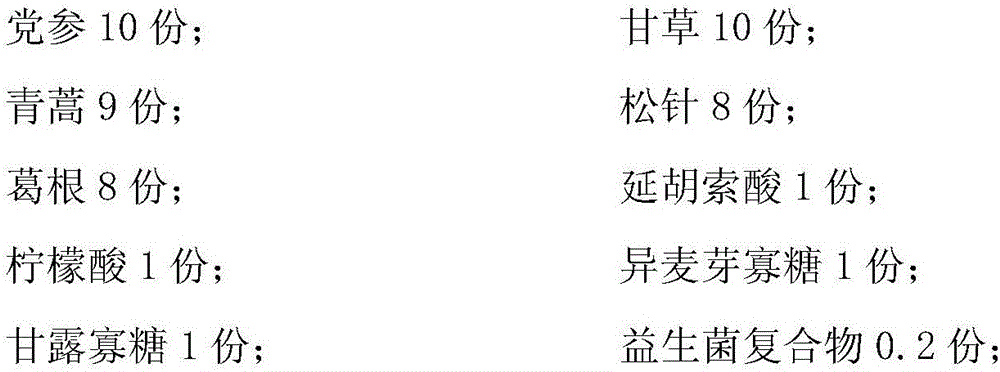Squab breeding method capable of preventing diseases
A breeding method and technology for pigeons, applied in the field of breeding, can solve the problems of poor disease resistance of pigeons, high mortality of pigeons, and reduce breeding efficiency, and achieve the goals of reducing morbidity, improving survival rate, and increasing feed intake. Effect
- Summary
- Abstract
- Description
- Claims
- Application Information
AI Technical Summary
Problems solved by technology
Method used
Image
Examples
Embodiment 1
[0034] 1. Preparation of anti-disease solution
[0035] (1) After mixing astragalus, flavescens, licorice, citrus aurantium, schisandra and purslane in a mass ratio of 3:2:3:1:2:2, after ultrasonic extraction at a frequency of 30KHz for 30min, the described Disease prevention extract;
[0036] (2) Mix the disease-preventing extract and distilled water uniformly at a volume ratio of 1:100 to obtain the disease-preventing liquid.
[0037] 2. Preparation of disease prevention feed
[0038] (1) Preparation of disease prevention additives
[0039] a. In parts by weight, take the following raw material components:
[0040]
[0041] Wherein, the probiotic complex is mainly made by mixing Streptococcus lactis, Saccharomyces cerevisiae, Lactobacillus bifidum, Lactobacillus acidophilus and Bacillus cereus in a weight ratio of 3:1:2:1:1;
[0042] b. Mix well weighed Codonopsis pilosula, licorice, Artemisia annua, pine needles and kudzu root, and sieve through low-temperature ultra...
Embodiment 2
[0061] 1. Preparation of anti-disease solution
[0062] (1) After mixing astragalus, flavescens, licorice, citrus aurantium, schisandra and purslane in a mass ratio of 3.5:2.5:3.5:1.5:2.5:2.5, after ultrasonic extraction at a frequency of 32KHz for 33 minutes, the described Disease prevention extract;
[0063] (2) Mix the disease-preventing extract and distilled water uniformly at a volume ratio of 1.5:105 to obtain the disease-preventing liquid.
[0064] 2. Preparation of disease prevention feed
[0065] (1) Preparation of disease prevention additives
[0066] a. In parts by weight, take the following raw material components:
[0067]
[0068] Wherein, the probiotic complex is mainly made by mixing Streptococcus lactis, Saccharomyces cerevisiae, Lactobacillus bifidum, Lactobacillus acidophilus and Bacillus cereus in a weight ratio of 4:2:3:1:2;
[0069] b. Mix well weighed Codonopsis pilosula, licorice, Artemisia annua, pine needles and kudzu root, and sieve through lo...
Embodiment 3
[0088] 1. Preparation of anti-disease solution
[0089] (1) After mixing astragalus, flavescens, licorice, citrus aurantium, schisandra and purslane in a mass ratio of 4:3:4:2:3:3, after ultrasonic extraction at a frequency of 35KHz for 35min, the described Disease prevention extract;
[0090] (2) Mix the disease-preventing extract and distilled water uniformly at a volume ratio of 2:110 to obtain the disease-preventing liquid.
[0091] 2. Preparation of disease prevention feed
[0092] (1) Preparation of disease prevention additives
[0093] a. In parts by weight, take the following raw material components:
[0094]
[0095] Wherein, the probiotic complex is mainly made by mixing Streptococcus lactis, Saccharomyces cerevisiae, Lactobacillus bifidum, Lactobacillus acidophilus and Bacillus cereus in a weight ratio of 5:3:4:2:3;
[0096] b. Mix well weighed Codonopsis pilosula, licorice, Artemisia annua, pine needles and kudzu root, and sieve through low-temperature ultra...
PUM
 Login to View More
Login to View More Abstract
Description
Claims
Application Information
 Login to View More
Login to View More - Generate Ideas
- Intellectual Property
- Life Sciences
- Materials
- Tech Scout
- Unparalleled Data Quality
- Higher Quality Content
- 60% Fewer Hallucinations
Browse by: Latest US Patents, China's latest patents, Technical Efficacy Thesaurus, Application Domain, Technology Topic, Popular Technical Reports.
© 2025 PatSnap. All rights reserved.Legal|Privacy policy|Modern Slavery Act Transparency Statement|Sitemap|About US| Contact US: help@patsnap.com



